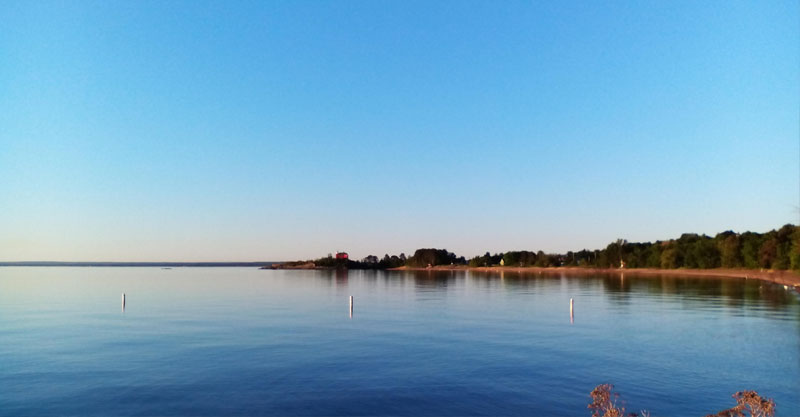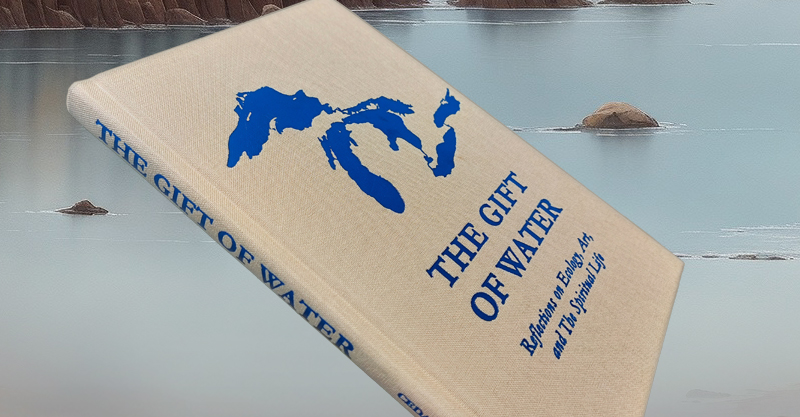The Gift of Water
as seen in the Marquette Monthly August, 2017
By Jon Saari
I recently visited an 850-year-old Cistercian Catholic monastery in Lower Austria, just outside the city of Zwettl. The site, located on a small river, was chosen for its remoteness as well as for the fertility of its fields and forests, which provided the monks with a livelihood. At the heart of the complex was a cloistered courtyard, which to my eyes presented an orderly Christian vision of the Garden of Eden.
The courtyard was surrounded by arcades with 365 small gothic pillars, one for each day of the year. The courtyard itself was open to the sky, and visible through the pillars. It contained five hedge-lined circles of plants of different colors, and one young sturdy tree, which represented the Tree of Life. The courtyard also contained a lavatorium with a stone water fountain, which appeared to me like a circular basin resembling a lotus flower. Six of us visitors, all holding hands, could just reach around the fountain. There was no free hand to take a photo.
Just as well. The beauty of the moment was inside us as well as in the quiet water and serene courtyard. (For images of the courtyard, see the photo gallery in the Wikipedia entry for Zwettl monastery.)
Monasteries are special places where lives can be lived with less distraction, and simple yet demanding rituals frame the daily and seasonal rounds. Some Christian interpreters of our era, like Rod Dreher, see monasteries as examples of intentional communities that provide the best hope for stemming the amoral tides of capitalism and technology. Modernity may be unstoppable, akin to the Biblical Flood, but perhaps intentional faith communities can function as arks that carry humanity across the dark seas of the present age. The call, then, is to turn inward to create a modern, community-based monasticism, in strategic retreat from the currents of modernity.
All faith communities to a degree are in tension with modernity and popular culture. While not monastic orders, they are local, engaged in serious conversations on real subjects, and committed to promoting spiritual practice among their members. Lake Superior Zendo in Marquette carries on a long tradition of Zen Buddhist practice that centers on quiet sitting, believing that such sitting slows practitioners down and opens our deepest selves. Members are wary about conventional pursuits of success and fame. Along with others, they are earth keepers and water stewards, paying attention to the interconnectedness of all forms of life and matter.
Consider thus far these contrasting water images: a quiet fountain in a holy place, and a raging flood of modernity that carries all before it, except what can be salvaged and modeled in intentional communities. But the analogy to water as quiet pool and raging flood is incomplete, for water is transformative. It can freeze into a solid, and dissipate into vapors. Some of our most common and memorable experiences in the U.P. are connected to these other forms of water: Snow drifts sculpting the landscape, huge icicles dripping from caves and cliffs, steam rising from hot sauna stones, or morning mists hovering over Lake Superior. Some of the most beautiful images of water that my photographer wife Christine has captured are evanescent frost landscapes on our bedroom window. This beauty is also a gift of water.
In the Chinese Taoist tradition, which underlies and is fused with Chinese Ch’an (Zen) Buddhism, this transformative power of water becomes integral to representing reality itself, the interplay of mind and landscape. In a recent book-length study, David Hinton, a scholar of Chinese language, philosophy and art, uses one Chinese painting, a landscape by Shih Tao, to make his point. (His book is entitled: Existence: A Story). The image portrays two small human figures on a mountain summit contemplating a range of receding snowcapped mountains and dispersing clouds. Spaces are left white on the scroll, suggesting the generation of forms out of emptiness. Mists and clouds blur boundaries and edges. Nothing stays the same for very long, says the painting, not even mountains. Beginnings and endings are mere words without meaning. Everything is impermanent, in flux, changing. In Taoist-inspired paintings the transformative power of water in its various states is a powerful assist to understanding this vast cosmic drama. It is a gift almost beyond reckoning.
WATER SAVER TIPS
Set your mower blades one notch higher, since longer grass means less evaporation, and place mulch around plants to reduce evaporation and discourage weeds.
Use a bucket instead of a hose to wash your car, and use a broom rather than a hose to clean sidewalks, driveways, loading docks and parking lots.

“The Gift of Water” columns are offered by the Northern Great Lakes Water Stewards and the Cedar Tree Institute, joined in an interfaith effort to help preserve, protect, and sanctify the waters of the Upper Peninsula.







